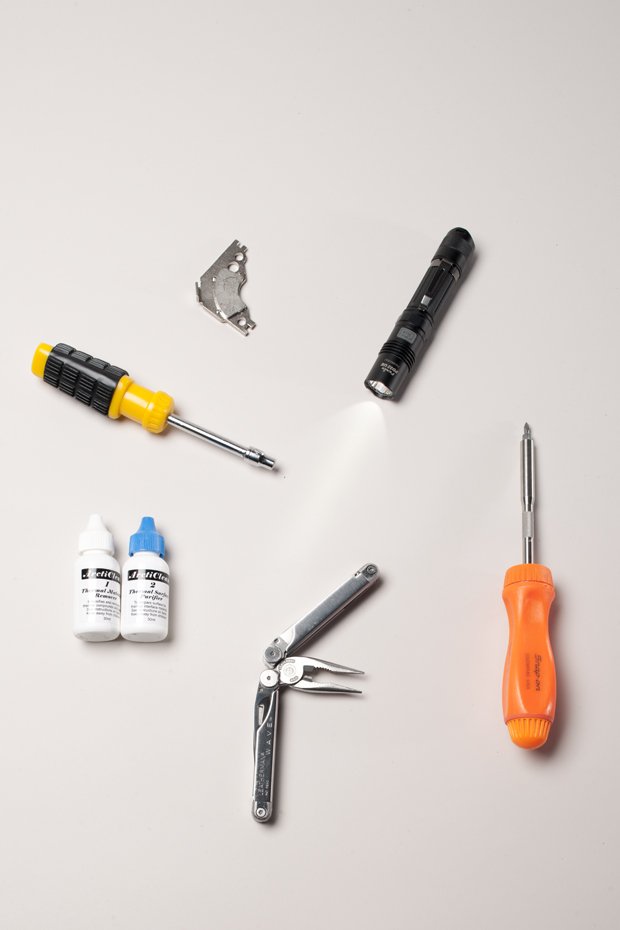Essential PC Building Tips
Screw Recognition Guide
There are four common screws used to build every PC. If you’re salty enough, you should be able to reach into a bucket of them and, by feel, pull out the right one.

Thumbscrew
The thumbscrew usually uses the same thread pitch per inch as the #6-32 screw and is provided on nicer cases to fasten the GPU and side panels. In a pinch, these screws can be used on the hard drive and motherboard if there’s enough clearance.
#6-32
The course-thread #6-32 in hex-head is the most important screw in your PC and is used to mount everything from a hard drive, to the side panel, GPU, and PSU. In most cases (but not all) it’s also used on the mobo. It can also be seen with a flat head or round head.
Fan Screw
This course little bastard is used to mount plastic fans to your case. It works by cutting into the plastic of the fan when you screw it down. Yeah, we know, not exactly a precision instrument but it works well enough—until you strip out the hole in the fan.
Keep up to date with the most important stories and the best deals, as picked by the PC Gamer team.
M3 Hex
The fine-thread M3 hex or round-head screw has two jobs: the optical drive and the SSD. People commonly mistake the M3 for the course #6-32 and use them to screw down the motherboard, but the ill-fitting screws will eventually back out.
DIY vs. Buy
When we solicited system builders for their expert building tips, a few of the PC vendors told us to go make like bacteria and self-replicate. After all, they argued, it’s far better to buy a system from people who do it for a living. Is it really, though? Here are a few key arguments the pros have in their favor.
You Don’t Have Intel’s Phone Number
OEMs, even small ones, have Intel , AMD , Nvidia , and pretty much all of the hardware makers on speed-dial when a problem crops up. And believe us, they get the attention a DIYer couldn’t imagine in their wildest water-cooled dreams.
You Pay Retail
Sure, you might get a killer deal on Slickdeals.net for a particular component, but you mostly pay full retail for parts. OEMs buy parts by the truckload, and if they’re big enough, by the freight-train-load. That gives them price margins you’ll never touch.
They Have Engineers
Unlike most DIYers, OEMs, especially the big boys, have engineers that can tell them, well, no you can’t run that much hardware with that small a PSU, or, no, that heatsink isn’t up to the job. All you have is a bunch of washed-up hacks at a magazine.
They Get the Truth
When dealing with the press and public, most corporations would rather ignore a problem than admit they screwed up. With system OEMs, however, parts makers are usually far more frank in warning them not to use one component with another, and then swear them to an NDA.
Tools of the Trade
To build a modern PC, the only tool you really need is a $3.99 screwdriver from the local ACE hardware store, but that doesn’t mean a few additional tools can’t make your PC building life a whole lot easier.

Socket
The vast majority of cases use brass standoff studs to mount a mobo. The ghetto method (which we admit to employing at times) is to use a pair of pliers on them. A simple 5mm or 3/16 socket is actually the right tool for the job.
ArctiClean
Although rubbing alcohol will work for cleaning up a CPU, we prefer ArctiClean, which requires less elbow grease. If you build more than one system, invest in some.
Magnet
Magnetizing your screwdrivers can make them much more effective in tight or hard-to-reach spots. This is where a dead hard drive comes in handy. Take it apart and extract the heavy-duty magnet that resides under the actuator. Let your tools rest on this bad boy a few seconds to become magnetized.
Leatherman
What can we say, it’s the Swiss Army Knife of PC building. If a tool’s not on there, you don’t need it.
Light Source
A flashlight or headlamp can make your build go a lot easier. Half our staff prefers handheld “torches,” the other favors the head-mounted variety. This Fenix PD32 Ultimate Edition ($70, www.fenixlight.com ) puts out a nice warm, floodlight-like beam at up to 740 lumens.
Quality Screwdriver
While you can get by with the $3.99 jobbie from the local ACE to build a PC, having a good-quality ratcheting screwdriver, such as this vintage Snap-On SSDMR4 ($64, www.snapon.com ), puts less strain on your hand and wrist, and can make your build a true joy.
Click the next page for airflow tips!

